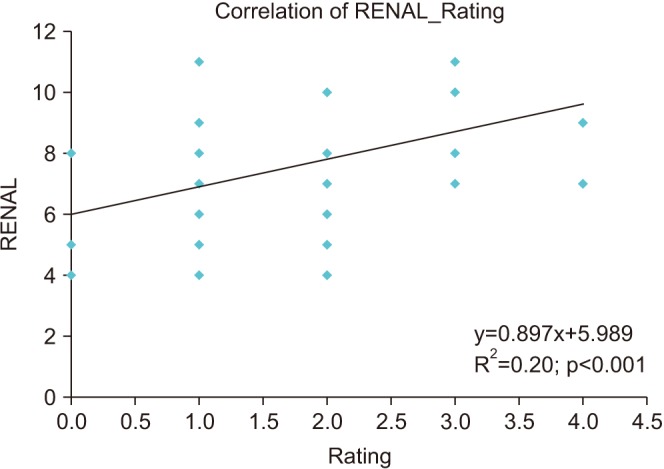Investig Clin Urol.
2018 Sep;59(5):305-312. 10.4111/icu.2018.59.5.305.
Predicting trifecta outcomes after robot-assisted nephron-sparing surgery: Beyond the nephrometry score
- Affiliations
-
- 1Department of Urology, Post Graduate Institute of Medical Education and Research, Chandigarh, India. aditya.p.sharma@gmail.com
- KMID: 2419413
- DOI: http://doi.org/10.4111/icu.2018.59.5.305
Abstract
- PURPOSE
RENAL nephrometry score (RNS) was devised for deciding the approach for renal tumors. It is increasingly used in predicting perioperative outcomes with variable results. The actual difficulty encountered during surgery depends on a number of other variables. The main purpose of this prospective study was to identify these variables which are not addressed by current RNS.
MATERIALS AND METHODS
Forty-nine patients undergoing robotic nephron sparing surgery from January 2015 onward were included. RNS was calculated from the imaging. Operating surgeon rated each surgery on a Likert scale of 0-4 after the completion of the procedure. The questionnaire was pre-validated in 5 cases before administration. The correlation between the surgeon rating and RNS with perioperative parameters and trifecta outcomes were calculated.
RESULTS
Forty-seven percent surgeries were rated easy, and 53.0% were rated as difficult. Surgeries for hilar, posterior location and presence of supernumerary vessels were found to be the a cause of difficulty. Trifecta outcomes were achieved in 37/49 patients (75.5%). The mean rating was 2.580±0.900 in trifecta negative patients while it was 1.410±0.832 in trifecta positive patient (p < 0.0001). Surgeon's rating correlated positively with trifecta outcomes (likelihood ratio=15.75, p=0.006).
CONCLUSIONS
The RNS remained a useful tool for determining renal tumor complexity. The intraoperative difficulty faced by the surgeon can be rated which can better predict perioperative trifecta outcomes. A useful predicting tool can be developed using the two parameters (RNS and surgeon rated difficulty).
Keyword
MeSH Terms
Figure
Reference
-
1. Kutikov A, Uzzo RG. The R.E.N.A.L. nephrometry score: a comprehensive standardized system for quantitating renal tumor size, location and depth. J Urol. 2009; 182:844–853. PMID: 19616235.
Article2. Gupta GN, Boris R, Chung P, Linehan WM, Pinto PA, Bratslavsky G. Robot-assisted laparoscopic partial nephrectomy for tumors greater than 4 cm and high nephrometry score: feasibility, renal functional, and oncological outcomes with minimum 1 year follow-up. Urol Oncol. 2013; 31:51–56. PMID: 21292511.3. Abdel Raheem A, Alatawi A, Kim DK, Sheikh A, Alabdulaali I, Han WK, et al. Outcomes of high-complexity renal tumours with a Preoperative Aspects and Dimensions Used for an Anatomical (PADUA) score of ≥10 after robot-assisted partial nephrectomy with a median 46.5-month follow-up: a tertiary centre experience. BJU Int. 2016; 118:770–778. PMID: 27102977.
Article4. Kim DK, Kim LH, Raheem AA, Shin TY, Alabdulaali I, Yoon YE, et al. Comparison of trifecta and pentafecta outcomes between T1a and T1b renal masses following robot-assisted partial nephrectomy (RAPN) with minimum one year follow up: can RAPN for T1b renal masses be feasible? PLoS One. 2016; 11:e0151738. PMID: 26987069.
Article5. Hung AJ, Cai J, Simmons MN, Gill IS. “Trifecta” in partial nephrectomy. J Urol. 2013; 189:36–42. PMID: 23164381.
Article6. Gill IS. Towards the ideal partial nephrectomy. Eur Urol. 2012; 62:1009–1010. PMID: 22858457.
Article7. Zargar H, Allaf ME, Bhayani S, Stifelman M, Rogers C, Ball MW, et al. Trifecta and optimal perioperative outcomes of robotic and laparoscopic partial nephrectomy in surgical treatment of small renal masses: a multi-institutional study. BJU Int. 2015; 116:407–414. PMID: 25220543.
Article8. Parekh DJ, Weinberg JM, Ercole B, Torkko KC, Hilton W, Bennett M, et al. Tolerance of the human kidney to isolated controlled ischemia. J Am Soc Nephrol. 2013; 24:506–517. PMID: 23411786.
Article9. Mir MC, Pavan N, Parekh DJ. Current paradigm for ischemia in kidney surgery. J Urol. 2016; 195:1655–1663. PMID: 26804756.
Article10. Okhunov Z, Rais-Bahrami S, George AK, Waingankar N, Duty B, Montag S, et al. The comparison of three renal tumor scoring systems: C-Index, P.A.D.U.A., and R.E.N.A.L. nephrometry scores. J Endourol. 2011; 25:1921–1924. PMID: 21905850.
Article11. Roushias S, Vasdev N, Ganai B, Mafeld S, Rix D, Thomas D, et al. Can the R.e.N.a.L nephrometry score preoperatively predict postoperative clinical outcomes in patients undergoing open and laparoscopic partial nephrectomy? Curr Urol. 2013; 7:90–97. PMID: 24917765.
Article12. Acar Ö, Işık EÖ, Mut T, Sağlıcan Y, Onay A, Vural M, et al. Comparison of the trifecta outcomes of robotic and open nephron-sparing surgeries performed in the robotic era of a single institution. Springerplus. 2015; 4:472. PMID: 26361573.
Article13. Qi J, Yu Y, Huang T, Bai Q, Kang J, Liang J, et al. Predictors of postoperative renal functional damage after nephron-sparing surgery. World J Surg Oncol. 2013; 11:216. PMID: 23987305.
Article14. Hew MN, Baseskioglu B, Barwari K, Axwijk PH, Can C, Horenblas S, et al. Critical appraisal of the PADUA classification and assessment of the R.E.N.A.L. nephrometry score in patients undergoing partial nephrectomy. J Urol. 2011; 186:42–46. PMID: 21571340.
Article15. Yeon JS, Son SJ, Lee YJ, Cha WH, Choi WS, Chung JW, et al. The nephrometry score: is it effective for predicting perioperative outcome during robot-assisted partial nephrectomy? Korean J Urol. 2014; 55:254–259. PMID: 24741414.
Article16. Sharma P, McCormick BZ, Zargar-Shoshtari K, Sexton WJ. Is surgeon intuition equivalent to models of operative complexity in determining the surgical approach for nephron sparing surgery? Indian J Urol. 2016; 32:124–131. PMID: 27127355.
Article17. Bora GS, Mavuduru RM, Sharma AP, Devana SK, Kakkar N, Lal A, et al. Initial experience of robotic nephron sparing surgery in cases of high renal nephrometry scores. Indian J Urol. 2017; 33:230–235. PMID: 28717275.
- Full Text Links
- Actions
-
Cited
- CITED
-
- Close
- Share
- Similar articles
-
- How far has robot-assisted partial nephrectomy reached?
- Comparison of Renal Function between Robot-Assisted and Open Partial Nephrectomy as Determined by Tc 99m-DTPA Renal Scintigraphy
- Simultaneous Robot-Assisted Laparoendoscopic Single-Site Partial Nephrectomy and Standard Radical Prostatectomy
- Nerve-sparing techniques and results in robot-assisted radical prostatectomy
- Single-port robot-assisted prosthetic breast reconstruction with the da Vinci SP Surgical System: first clinical report




